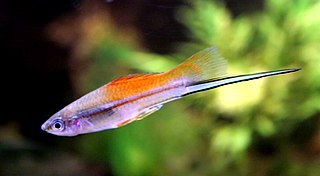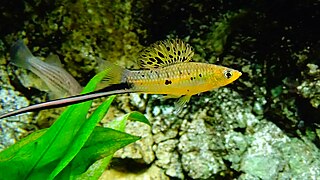
The southern platyfish, common platy, or moonfish is a species of freshwater fish in family Poeciliidae of order Cyprinodontiformes. A live-bearer, it is closely related to the green swordtail and can interbreed with it. It is native to an area of North and Central America stretching from Veracruz, Mexico, to northern Belize.

Xiphophorus is a genus of euryhaline and freshwater fishes in the family Poeciliidae of order Cyprinodontiformes, native to Mexico and northern Central America. Xiphophorus species can be divided into 3 groups based on their evolutionary relationships: platyfish, northern swordtails, and southern swordtails. Platyfish formerly were classified in another genus, Platypoecilus, which is now obsolete. The type species is X. hellerii, the green swordtail. Like most other new world Poeciliids, platies and swordtails are live-bearers that use internal fertilization and give birth to live young instead of laying eggs like the bulk of the world's fishes. The name Xiphophorus derives from the Greek words ξίφος (dagger) and φόρος (bearer), referring to the gonopodium on the males. All are relatively small fishes, which reach a maximum length of 3.5–16 cm (1.4–6.3 in) depending on the exact species involved.

The Monterrey platyfish is a species of freshwater fish in family Poecilidae. A live-bearer, it was native to a very small section of the San Juan River system in the vicinity of the city of Monterrey, Mexico. The specific name refers to the American soldier and naturalist Darius N. Couch (1822–1897) who collected the type on a self financed expedition to Mexico.

Anomalochromis is a genus of fish in the family Cichlidae, containing the single species Anomalochromis thomasi, the African butterfly cichlid. It is a small cichlid growing to a length of 6–8 centimetres (2.4–3.1 in). The natural habitat of A. thomasi is Sierra Leone, Liberia and Guinea, mainly in smaller streams. The fish are typically found in slightly acidic, oxygen rich water with other west African cichlid genera such as Hemichromis and Pelvicachromis.

Sicyopterus stimpsoni, commonly known as the Nopili rockclimbing goby, oopu nopili, or Stimpson's goby, is a species of amphidromous goby endemic to the islands of Hawai‘i. This species can reach a length of 19.8 centimetres (7.8 in) SL.
The yellow swordtail is a species of freshwater fish in the family Poeciliidae. It is endemic to the upper Coatzacoalcos River basin in southern Mexico. It is typically found in brooks and streams with slow current; it is less frequent in areas with strong current. The yellow swordtail is considered a threatened species by Mexican authorities. It reaches up to 5.1 cm (2.0 in) in standard length.
The northern platyfish is a small, endangered species of fish in the family Poeciliidae. It is endemic to the vicinity of Cuatro Ciénegas in the Mexican state of Coahuila. It is restricted to hot-spring heated ditches and marshes of the Laguna Santa Tecla. Its native water is shallow and vegetation-choked, with very stable temperatures that generally are around 27–30 °C (81–86 °F), although captive studies show the species also can live in slightly colder water.
The marbled swordtail is a species of freshwater fish in the family Poeciliidae. It was endemic to the Rio Salado system in Coahuila, northeastern Mexico. It was restricted to springs, connected creeks and pools in waters with a pH slightly above neutral and temperatures of 16–26 °C (61–79 °F), with captive studies indicating that the optimum temperature is around 24 °C (75 °F).

The green swordtail is a species of freshwater/brackish fish in family Poeciliidae of order Cyprinodontiformes. A live-bearer, it is closely related to the southern platyfish or 'platy' (X. maculatus) and can crossbreed with it. It is native to an area of North and Central America stretching from Veracruz, Mexico, to northwestern Honduras.

Xiphophorus nigrensis, the Panuco swordtail, is a species of fish in the family Poeciliidae that is endemic to a small part of the Pánuco River basin in Mexico.
Xiphophorus mayae is a fish in the family Poeciliidae. It is found in Central America: eastern Guatemala and western Honduras. This species has red lines on its body which extend on to the upper portion of the caudal fin, males have the lower part of the caudal fin extended into a "sword".

Xiphophorus montezumae, the Montezuma swordtail, is a livebearing freshwater fish of the order Cyprinodontiformes, family Poeciliidae, and genus Xiphophorus. It is in the same genus as the common platy and the swordtail. Xiphophorus means 'sword-bearer' in Greek.

Xiphophorus nezahualcoyotl, the mountain swordtail, is a live bearing fish in the family Poeciliidae. It is endemic to the northwestern Pánuco River basin in Mexico. The specific name of this fish refers to the poet, philosopher and emperor of Texcoco, Nezahualcoyotl (1402-1472).
Xiphophorus birchmanni, commonly known as the sheephead swordtail, is a live bearing fish in the family Poeciliidae.

Xiphophorus continens, also known as El Quince swordtail or short-sword platyfish, is a live-bearing freshwater fish in the family Poeciliidae. It is endemic to the Pánuco River basin in east-central Mexico. Its name comes from the Greek conto, meaning short, and Latin ensis, meaning "sword". due to the species' sword size in males.
Xiphophorus malinche, also known as highland swordtail, is a live bearing fish in the family Poeciliidae. It is endemic to the Pánuco River basin in east-central Mexico. This species is named after La Malinche, an Indian slave who played a role in the Spanish conquest as the interpreter, secretary, and mistress of Hernando Cortes.

Xiphophorus pygmaeus, the pygmy swordtail, is a poeciliid fish from northeastern Mexico. It is the smallest of the swordtails. The male's sword is barely visible and the species is often called the swordless swordtail. It is sometimes kept in home aquaria, but is a rather delicate species.

Xiphophorus milleri, the Catemaco platyfish, is a poeciliid fish endemic to Mexico's Lake Catemaco and its tributaries. As it has traits of both swordtails and platies, its discovery confirmed that these two groups should be consolidated into a single genus, Xiphophorus.

Xiphophorus cortezi, the delicate swordtail, is a species of poeciliid fish from Mexico.

Xiphophorus signum is a poeciliid fish endemic to Guatemala. It occurs in only one creek and adjacent pools, making it a vulnerable species.














